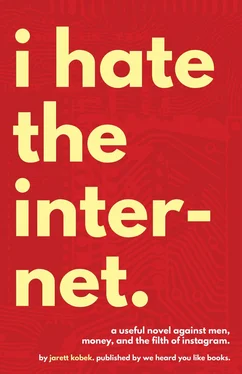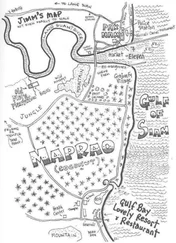On the Internet, Emil offered a very different self-portrait than one might deduce from his California dialect. His intellectual output was full of words that he’d learned during his foundation year at CalArts.
He had been taught theory. His fellow students had recommended essential books, most of which were post-theory novels.
Whenever Emil posted something on the Internet, he included a great deal of jargon like epistemology, ontology, intertextuality, binaries, intersectionality, extrarationality and improvisational impulse.
Yet whenever Emil was involved in a vocal conversation, his California roots betrayed him. He sounded like a media stereotype.
The split between his written and spoken selves was startling, but not unusual for kids involved in the Los Angeles art scene. There were thousands of them. They all used the Internet to articulate what they could not articulate in person.
For all of her flaws, Adeline was flush with a mother’s forgiving love. She had never noticed that her son sounded like an idiot.
A thing that Adeline had never told anyone, not even Baby, was the real reason why she let Emil go live with Nash Mac.
It wasn’t that Adeline didn’t take responsibility. It was that Adeline took too much responsibility. She let Emil go live with Nash Mac because she’d felt guilty.
Guilty about bringing a child into her weird life, guilty about subjecting Emil to her family and her friends, guilty about putting Emil into a situation beyond his control, guilty about robbing him of his own choices, guilty of sticking him on a planet that had less than a century left.
The only thing a parent need do, thought Adeline, was to inflict as little damage as possible and give their children the tools to handle future damage done by others.
She honored the feeling. She let Emil live where he wanted and hoped that things would repair themselves.
She was waiting for the verdict. The jury was still out.
“Enough about this Twitter nonsense, darling. Tell me, how are you? How ever is your band?”
“It’s not a band, Mom,” said Emil. “I’ve told you, like, a million times. We’re not a fucking band. No one plays instruments. It’s really not a fucking band.”
“Sorry, darling,” said Adeline.
J. Karacehennem left his apartment near the corner of 23rd and Bryant. He was alone. He was going to a literary event where he would read aloud some of his own writing.
The Hangman’s Beautiful Daughter was not coming along. The Hangman’s Beautiful Daughter did not like his writing.
When he published his novel ZIAD , The Hangman’s Beautiful Daughter read it. She said there were some nice parts but she didn’t think the book was that interesting.
“What do you mean it’s not interesting?” asked J. Karacehennem. “It’s about Ziad Jarrah! One of the 9/11 pilots! It’s a book about a psychopath who wants to crash a hijacked plane into the Capitol building! He fucked up your whole world forever! What could be more interesting?”
“It’s just more masculine bullshit,” said The Hangman’s Beautiful Daughter. “Men are always writing books about killing each other. When they aren’t writing books about killing each other, then they’re just killing each other.”
Anyway, The Hangman’s Beautiful Daughter had been to a great number of J. Karacehennem’s literary readings. She had seen enough. She didn’t need to keep going.
She was skipping this one.
That very morning, J. Karacehennem had woken up and walked past Local’s Corner. Local’s Corner was the public relations disaster of a restaurant opened at 23rd and Bryant.
The previous evening, someone had vandalized the restaurant. They had used purple spray paint to tag its windows with graffiti. The graffiti read:
KEEP MISSION BROWN
Mission was the neighborhood in which Local’s Corner was located. Brown was a colloquialism indicating the writer of the graffiti’s desire to maintain the historically Latino character of the Mission.
A few weeks earlier, on Cesar Chavez Day, a woman named Sandra Cuadra and her family went to Local’s Corner. They were a party of five. They all had eumelanin in the basale strata of their epidermises.
They were turned away.
The server would not seat Sandra Cuadra.
An explanation floated later was that Local’s Corner didn’t accommodate parties bigger than four people.
Sandra Cuadra was a long time resident of the Mission. She was Latino. She was Brown. She was an activist and a former city employee.
She sent email to a wide group of people. She detailed her experiences with Local’s Corner.
Latino people were feeling squeezed by the forces of gentrification. Their neighborhood was being pulled apart by the whims of mega-capitalists, low interest rates, investors from out of town, and corporations located in Silicon Valley.
And there was Local’s Corner, the most obvious and tone deaf symbol of the changes wrought on the neighborhood.
It had denied a Latino family service. On Cesar Chavez Day. Its owner had a bad reputation around the neighborhood. The matriarch of that Latino family was a beloved neighborhood fixture.
So the vandalization and graffiti began.
Latino people were the genetic descendents of both the Western hemisphere’s indigenous peoples and the Spanish colonialists who had invaded the Americas. The Spanish colonialists started showing up at the end of the Fifteenth Century.
The Spanish colonialists had murdered and poisoned and infected the indigenous peoples of the Americas. Because the human race is driven by reproductive urges, the Spanish colonialists also vented their lust into the indigenous peoples of the Americas.
There were Portuguese colonists, too. From the perspective of the indigenous peoples who were being murdered and poisoned and raped and infected, the Portuguese were just Spaniards with a shittier accent.
Latino people were a diverse group of nationalities. Some Latino people had some eumelanin in the basale strata of the epidermises. Others did not.
The presence of some eumelanin in some Latino people is why someone had suggested keeping the neighborhood Brown .
When Spanish conquerors invaded the San Francisco Bay Area, the indigenous people were the tribes of the Ohlone people.
The narrative history of the Ohlone people was the same terrible narrative visited upon all the indigenous people of the Americas. Death and depopulation through infection, murder and rape.
Before the Spanish arrived, there were tens of thousands of Ohlones in California. There were about 2,000 in 2013.
The thing with the Ohlones wasn’t simply a Spanish problem or a California problem. All of the United States of America was stolen land.
The treatment of the indigenous people of the United States of America was the world’s biggest genocide.
Americans loved doing things in a really big way. They couldn’t help it. They were maniacs for obscene consumption. Americans were nuts for the enlarged and its attendant dramas.
Here is an apparently true story.
Prescott Bush was the father of George Bush I and the grandfather of George Bush II. He was the guy who worked for a Nazi bank.
The story goes that Prescott Bush and five other guys dug up the grave of Geronimo.
Geronimo was an Apache warrior. The Apaches were a grouping of indigenous people of some eumelanin in the basale strata of their epidermises whose way of life was destroyed during the genocide.
Prescott Bush and the five other guys were all students at Yale. They were all part of a secret society called Skull and Bones.
Yale was a university. Universities were confidence games which pretended to ennoble their students through pedagogy. What universities really did was simple: they were research institutions that created better weapons for future wars.
Читать дальше












